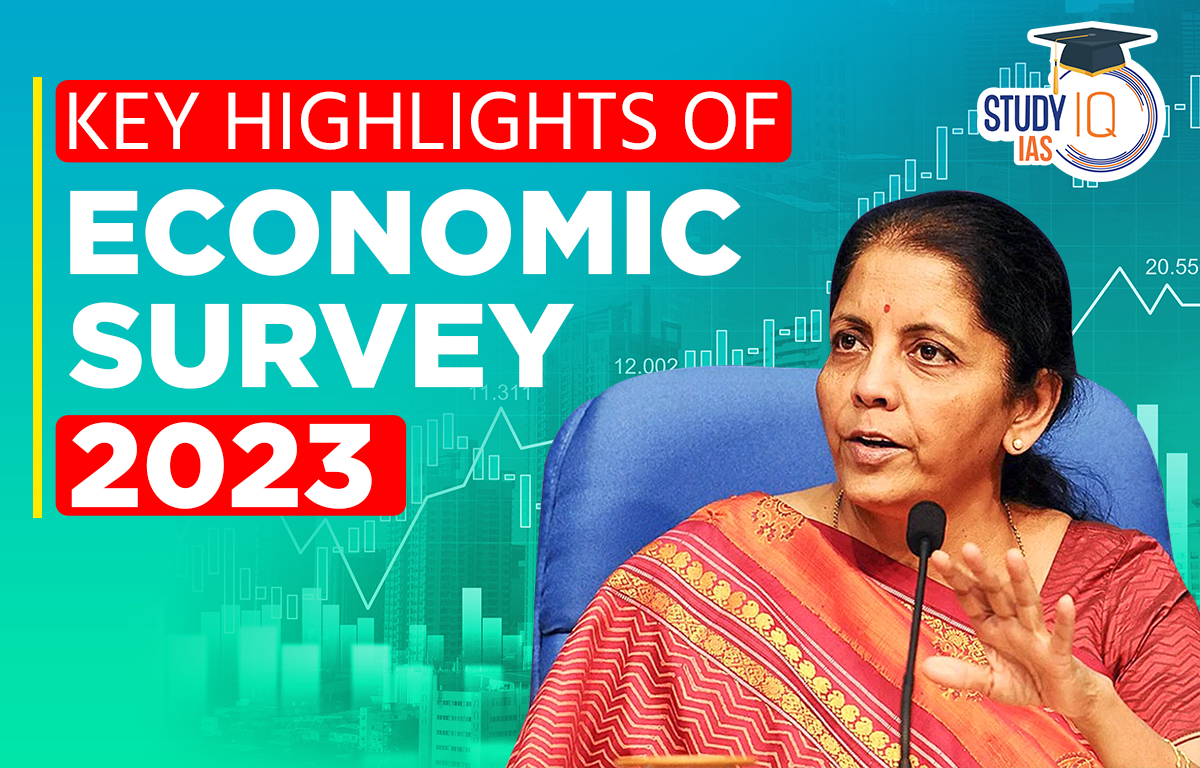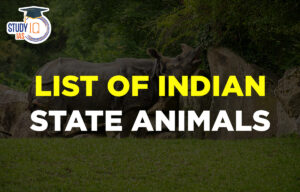Table of Contents
Context: Recently, Economic Survey for 2022-23 was tabled in the Parliament, a day ahead of the Union Budget.
About Economic Survey
- It is a detailed report of the state of the national economy in the financial year that is coming to a close.
- It is prepared by the Economic Division of the Department of Economic Affairs (DEA) under the guidance of the Chief Economic Adviser (CEA).
- The survey is approved by the Finance Minister.
- First Economic Survey was presented for 1950-51 and until 1964, it was presented along with the Budget.
- Significance: It is an authoritative and comprehensive analysis of the economy that is conducted from within the Union government.
- Its observations and details provide an official framework for analysing the Indian economy.
- Its assessment and recommendations are not binding on the Budget.
Key Highlight of Economic Survey 2022-23
Overall Economy
- India’s economy to grow 6.5% in 2023-24, compared to 7% this fiscal and 8.7% in 2021-22.
- Gross domestic product (GDP) in nominal terms to be 11% in next fiscal.
- Growth is driven by private consumption, higher capex, strengthening corporate balance sheet, credit growth to small businesses and return of migrant workers to cities
- Inflation: The RBI has projected headline inflation at 6.8% in FY23, outside its comfort zone of 2% to 6%.
- ‘Entrenched Inflation’ may prolong the tightening cycle and therefore borrowing costs may stay higher for longer
- Unemployment: Periodic Labour Force Survey (PLFS) showed that urban unemployment rate for people aged 15 years and above declined from 9.8% in the quarter ending September 2021 to 7.2% one year later.
- Fall in unemployment rate is accompanied by an improvement in the labour force participation rate.
- Reform Period: Phase between 2014 and 2022 has witnessed wide-ranging structural and governance reforms that strengthened the economy’s fundamentals by enhancing its overall efficiency.
- However, reforms had not yielded the desired results due to:
- Non-performing assets (NPAs) of banks
- business firms were deleveraging.
- Global Shocks due to Covid pandemic and the Ukraine war.
Further Challenges
- Rupee depreciation could persists with the likelihood of further interest rate hikes by the US Fed
- Current account deficit (CAD) may continue to widen as global commodity prices remain elevated, economic growth momentum stays strong. If CAD widens further, rupee may come under depreciation pressure
- CAD widened to 4.4% of the GDP in the quarter ending September, from 2.2% of the GDP during the April-June period due to a higher trade gap, according to the latest Reserve Bank of India (RBI) data.
- However, India has sufficient forex reserves to finance CAD and intervene in forex market to manage rupee volatility
- The growth in exports has moderated in second half of current fiscal
- Slowing world growth, shrinking global trade led to loss of export stimulus in the second half of current year.
Industry
- Overall Gross Value Added (GVA) by the Industrial Sector (for the first half of FY 22-23) rose 3.7 per cent, which is higher than the average growth of 2.8 per cent achieved in the first half of the last decade.
- PMI manufacturing has remained in the expansion zone for 18 months since July 2021, and Index of Industrial Production (IIP) grows at a healthy pace.
- Credit to Micro, Small and Medium Enterprises (MSMEs) has grown by an average of around 30% since January 2022 and credit to large industry has been showing double-digit growth since October 2022.
- India has become the second-largest mobile phone manufacturer globally, with the production of handsets going up from 6 crore units in FY15 to 29 crore units in FY21.
Services
- Services sector is expected to grow at 9.1% in FY23, as against 8.4% (YoY) in FY22.
- India was among the top ten services exporting countries in 2021, with its share in world commercial services exports increasing from 3 per cent in 2015 to 4 per cent in 2021.
External Sector
- India is the largest recipient of remittances in the world receiving US$ 100 bn in 2022.
- Remittances are the second largest major source of external financing after service export
- As of end-November 2022, India is the sixth largest foreign exchange reserves holder in the world.
- India has relatively low levels of total debt as a percentage of Gross National Income and short-term debt as a percentage of total debt.
Social Infrastructure
- Social sector expenditure increases to Rs. 21.3 lakh crore in FY23 (BE) from Rs. 9.1 lakh crore in FY16.
- According to 2022 report of the UNDP on Multidimensional Poverty Index, that 41.5 crore people exit poverty in India between 2005-06 and 2019-20.
- JAM (Jan-Dhan, Aadhaar, and Mobile) trinity, combined with the power of DBT, has brought the marginalised sections of society into the formal financial system, revolutionising the path of transparent and accountable governance by empowering the people.
- FY22 saw improvement in Gross Enrolment Ratios (GER) in schools and improvement in gender parity.
- GER in the primary-enrolment in class I to V as a percentage of the population in age 6 to 10 years – for girls as well as boys have improved in FY22.
- Nearly 22 crore beneficiaries have been verified under the Ayushman Bharat Scheme as on 04 January, 2023.
- Over 1.54 lakh Health and Wellness Centres have been operationalized across the country under Ayushman Bharat.
Climate Change and Environment
- India declared the Net Zero Pledge to achieve net zero emissions goal by 2070.
- India achieved its target of 40 per cent installed electric capacity from non-fossil fuels ahead of 2030.
- India is likely to improve installed capacity from non-fossil fuels to be more than 500 GW by 2030 resulting in decline of average emission rate by around 29% by 2029-30, compared to 2014-15.
- India to reduce emissions intensity of its GDP by 45% by 2030 from 2005 levels.
- About 50% cumulative electric power installed capacity to come from non-fossil fuel-based energy resources by 2030.
- National Green Hydrogen Mission to enable India to be energy independent by 2047.
Agriculture and Food Management
- Private investment in agriculture increases to 9.3% in 2020-21.
- MSP for all mandated crops fixed at 1.5 times of all India weighted average cost of production since 2018.
- Institutional Credit to the Agricultural Sector continued to grow to 18.6 lakh crore in 2021-22
- Organic Farming being promoted through Farmer Producer Organisations (FPO) under the Paramparagat Krishi Vikas Yojana (PKVY).
- India stands at the forefront to promote millets through the International Year of Millets initiative.
Physical and Digital Infrastructure
- National Infrastructure Pipeline (NIP) is a group of social and economic infrastructure projects slated to be established over a period of five years with an initial sanctioned amount of ₹102 lakh crore.
- The NIP was first announced in 2019
- National Monetisation Pipeline (NMP): To unlock value in brownfield projects by engaging the private sector, transferring to them revenue rights and not ownership in the projects, and using the funds so generated for infrastructure creation across the country.
- NMP estimates aggregate monetisation potential of Rs 6.0 lakh crores through core assets of the Central Government, over a four-year period, from FY 2022 to FY 2025.
- Recently, India Infrastructure Project Development Fund Scheme (IIPDF Scheme) was notified.
- It is a scheme for financial support for project development expenses of Public-Private Partnership (PPP) Projects.
- PM GatiShakti National Master Plan: To improve multimodal connectivity and logistics efficiency while addressing the critical gaps for the seamless movement of people and goods.
- National Logistics Policy envisions to develop a technologically enabled, integrated, cost-efficient, resilient, sustainable and trusted logistics ecosystem in the country for accelerated and inclusive growth.
- Unified Payment Interface (UPI): UPI-based transactions grew in value (121 per cent) and volume (115 per cent) terms, between 2019-22, paving the way for its international adoption.
Infographic Highlight



 Daily Quiz 17 April 2025
Daily Quiz 17 April 2025
 Nilgiri Biosphere Reserve, Map, Climate,...
Nilgiri Biosphere Reserve, Map, Climate,...
 Complete List of Indian State Animals
Complete List of Indian State Animals





















